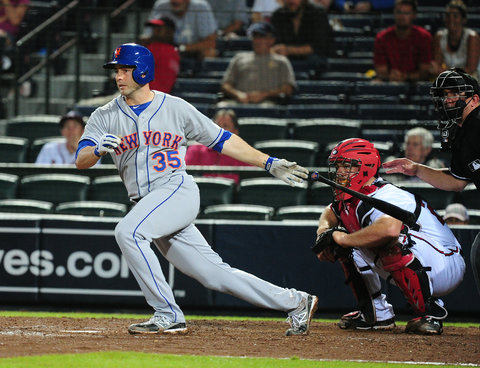
(Photo: Scott Cunningham/Getty Images)
Mets manager Terry Collins had spoken about the idea of hitting the pitcher eighth on several occasions. On Thursday, he put the idea into practice against the Braves. The result was a 7-6 win over Atlanta.
Did the new lineup construction play a major role in the offensive outburst? Probably not.
The idea behind batting the pitcher in the eighth spot is pretty simple. Placing a hitter in the ninth spot will give you a better chance at turning your lineup over and getting your third hitter, in this case David Wright, more chances to drive in runs. But does this method actually pay dividends? That’s what Jared Diamond of the Wall Street Journal hoped to find out in his very interesting article.
“If we’re not getting anybody on base ahead of him, we’ve got to come up with another formula to get guys on,” Collins, speaking about Wright, tells WSJ, “We’ve got to come up with something else.”
It appears to be sound logic. But how much of a difference does this approach really make? Diamond turned to Bill James, the goddfather of sabermetrics, for some help.
“You just can’t create runs—or lose them—by moving hitters around in the lineup,” said James, in an email.
Diamond decided to dig a little deeper, and came up with some interesting information.
Since 1980, teams have averaged 4.51 runs in the 423 games in which they batted their pitcher eighth. Those same teams averaged 4.33 runs in games in which they batted the pitcher ninth.
That may seem like a small difference, but with the Mets offense expected to once again struggle to put up respectable run totals, any chance for a small advantage should be explored. Diamond took the information to James, who seemed to agree with his findings.
“To the small extent that it may matter,” James wrote, “I think it is extremely likely that you’re better off with the pitcher batting eighth, rather than the pitcher batting ninth.”
Mets general manager Sandy Alderson also seems to be in favor of the new look lineup.
“I think what the data shows us is that over 162 games, there’s a small percentage increase in the number of RBI opportunities for somebody in the three hole,” Alderson exclaims. “That’s why we’re trying it.”
It appears the data seems to agree with the change, even if the payoff is pretty minute. However, given the Mets lack of offensive firepower, they should explore any and all avenues that may lead to more runs. It would also be interesting to see how the statistics would play out on a larger scale, being that the strategy has only been deployed 423 times in the last 30+ years. Perhaps the sample size is still too small, and if a team stuck to it over a full season the benefits would increase.
I’d like to see what the fans think, but before making your decision I suggest reading Jared’s entire article to see the rest of his findings by clicking here.
[polldaddy poll=7902671]














